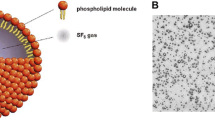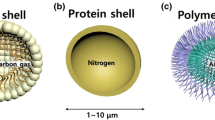Abstract
US is a low-cost, real-time imaging modality that is the most used diagnostic tool in paediatric radiology. Reasons include the improved US image quality in children as compared to adults and the demand for avoiding X-rays as much as possible because children are more sensitive to radiation than adults. Stabilized microbubbles have been approved as US contrast agents for adults and show great potential in improving the diagnostic accuracy for many diseases. Initial studies show that in paediatric radiology contrast-enhanced US could also be beneficial for more than just the diagnosis of vesicoureteral reflux, if US contrast agents were approved for children. Molecular US imaging utilizes microbubbles conjugated to biomolecules that target intravascular disease-specific molecules. Many preclinical studies show that molecular US imaging is a highly sensitive tool to detect neovascularisation, inflammation and cardiovascular diseases. Its main advantages are the higher informative value, the longer persistence of the label at the target lesion and the chance to work with lower contrast agent dosages. Now, clinical translation of molecular US appears at the horizon. This review article reports on the current status of molecular US imaging and discusses its potential for paediatric radiology.



Similar content being viewed by others
References
Wagenaar DJ, Weissleder R, Hengerer A (2001) Glossary of molecular imaging terminology. Acad Radiol 8:409–420
Kiessling F, Huppert J, Palmowski M (2009) Functional and molecular ultrasound imaging: concepts and contrast agents. Curr Med Chem 16:627–642
Klibanov AL (2007) Ultrasound molecular imaging with targeted microbubble contrast agents. J Nucl Cardiol 14:876–884
Villanueva FS (2008) Molecular imaging of cardiovascular disease using ultrasound. J Nucl Cardiol 15:576–586
Leighton TG (1997) The acoustic bubble. Academic Press, London
Ophir J, Parker KJ (1989) Contrast agents in diagnostic ultrasound. Ultrasound Med Biol 15:319–333
Klibanov AL, Rasche PT, Hughes MS et al (2002) Detection of individual microbubbles of an ultrasound contrast agent: fundamental and pulse inversion imaging. Acad Radiol 9:S279–281
Klibanov AL (2005) Ligand-carrying gas-filled microbubbles: ultrasound contrast agents for targeted molecular imaging. Bioconjug Chem 16:9–17
Schutt EG, Klein DH, Mattrey RM et al (2003) Injectable microbubbles as contrast agents for diagnostic ultrasound imaging: the key role of perfluorochemicals. Angew Chem Int Ed Engl 42:3218–3235
Dayton PA, Rychak JJ (2007) Molecular ultrasound imaging using microbubble contrast agents. Front Biosci 12:5124–5142
Palmowski M, Morgenstern B, Hauff P et al (2008) Pharmacodynamics of streptavidin-coated cyanoacrylate microbubbles designed for molecular ultrasound imaging. Invest Radiol 43:162–169
Palmowski M, Huppert J, Ladewig G et al (2008) Molecular profiling of angiogenesis with targeted ultrasound imaging: early assessment of antiangiogenic therapy effects. Mol Cancer Ther 7:101–109
Reinhardt M, Hauff P, Linker RA et al (2005) Ultrasound derived imaging and quantification of cell adhesion molecules in experimental autoimmune encephalomyelitis (EAE) by Sensitive Particle Acoustic Quantification (SPAQ). Neuroimage 27:267–278
Palmowski M, Peschke P, Huppert J et al (2009) Molecular ultrasound imaging of early vascular response in prostate tumors irradiated with carbon ions. Neoplasia 11:856–863
Lindner JR (2004) Microbubbles in medical imaging: current applications and future directions. Nat Rev Drug Discov 3:527–532
Lindner JR, Coggins MP, Kaul S et al (2000) Microbubble persistence in the microcirculation during ischemia/reperfusion and inflammation is caused by integrin- and complement-mediated adherence to activated leukocytes. Circulation 101:668–675
Christiansen JP, Leong-Poi H, Klibanov AL et al (2002) Noninvasive imaging of myocardial reperfusion injury using leukocyte-targeted contrast echocardiography. Circulation 105:1764–1767
Kondo I, Ohmori K, Oshita A et al (2004) Leukocyte-targeted myocardial contrast echocardiography can assess the degree of acute allograft rejection in a rat cardiac transplantation model. Circulation 109:1056–1061
Klibanov AL (2006) Microbubble contrast agents: targeted ultrasound imaging and ultrasound-assisted drug-delivery applications. Invest Radiol 41:354–362
Willmann JK, Lutz AM, Paulmurugan R et al (2008) Dual-targeted contrast agent for US assessment of tumor angiogenesis in vivo. Radiology 248:936–944
Wei K, Jayaweera AR, Firoozan S et al (1998) Quantification of myocardial blood flow with ultrasound-induced destruction of microbubbles administered as a constant venous infusion. Circulation 97:473–483
Krix M, Kiessling F, Vosseler S et al (2003) Sensitive noninvasive monitoring of tumor perfusion during antiangiogenic therapy by intermittent bolus-contrast power Doppler sonography. Cancer Res 63:8264–8270
Lanza GM, Wickline SA (2001) Targeted ultrasonic contrast agents for molecular imaging and therapy. Prog Cardiovasc Dis 44:13–31
Reinhardt M, Hauff P, Briel A et al (2005) Sensitive particle acoustic quantification (SPAQ): a new ultrasound-based approach for the quantification of ultrasound contrast media in high concentrations. Invest Radiol 40:2–7
Blomley M, Claudon M, Cosgrove D (2007) WFUMB Safety Symposium on Ultrasound Contrast Agents: clinical applications and safety concerns. Ultrasound Med Biol 33:180–186
Harding JA, Engbers CM, Newman MS et al (1997) Immunogenicity and pharmacokinetic attributes of poly(ethylene glycol)-grafted immunoliposomes. Biochim Biophys Acta 1327:181–192
Lencioni R, Della Pina C, Crocetti L et al (2007) Clinical management of focal liver lesions: the key role of real-time contrast-enhanced US. Eur Radiol 17:F73–79
Goyal N, Jain N, Rachapalli V et al (2009) Non-invasive evaluation of liver cirrhosis using ultrasound. Clin Radiol 64:1056–1066
Lassau N, Brule A, Chami L et al (2008) Evaluation of early response to antiangiogenic treatment with dynamic contrast enhanced ultrasound. J Radiol 89:549–555
Lassau N, Lamuraglia M, Chami L et al (2006) Gastrointestinal stromal tumors with imatinib: monitoring response with contrast-enhanced sonography. AJR 187:1267–1273
Weber MA, Krix M, Jappe U et al (2006) Pathologic skeletal muscle perfusion in patients with myositis: detection with quantitative contrast-enhanced US—initial results. Radiology 238:640–649
Darge K, Moeller RT, Trusen A et al (2005) Diagnosis of vesicoureteric reflux with low-dose contrast-enhanced harmonic ultrasound imaging. Pediatr Radiol 35:73–78
Ascenti G, Zimbaro G, Mazziotti S et al (2004) Harmonic US imaging of vesicoureteric reflux in children: usefulness of a second generation US contrast agent. Pediatr Radiol 34:481–487
Darge K, Beer M (2003) Advances in pediatric sonography. Radiologe 43:813–822
Sheil ML, Cartmill TB, Nunn GR et al (2003) Contrast echocardiography: potential for the in-vivo study of pediatric myocardial preservation. Ann Thorac Surg 75:1542–1548
Riccabona M, Uggowitzer M, Klein E et al (2000) Echo-enhanced color Doppler sonography in children and adolescents. J Ultrasound Med 19:789–796
Svensson JF, Larsson A, Uusijärvi J et al (2008) Oophoropexy, hyperbaric oxygen therapy, and contrast-enhanced ultrasound after asynchronous bilateral ovarian torsion. J Pediatr Surg 43:1380–1384
Hasegawa T, Kamiyama M, Azuma T et al (2000) Reversal of intrapulmonary arteriovenous shunting detected by two-dimensional contrast-enhanced echocardiography after liver transplantation. Transplantation 69:672–675
McCarville MB (2008) New frontiers in pediatric oncologic imaging. Cancer Imaging 8:87–92
Willmann JK, Paulmurugan R, Chen K et al (2008) US imaging of tumor angiogenesis with microbubbles targeted to vascular endothelial growth factor receptor type 2 in mice. Radiology 246:508–518
Korpanty G, Carbon JG, Grayburn PA et al (2007) Monitoring response to anticancer therapy by targeting microbubbles to tumor vasculature. Clin Cancer Res 13:323–330
Lyshchik A, Fleischer AC, Huamani J et al (2007) Molecular imaging of vascular endothelial growth factor receptor 2 expression using targeted contrast-enhanced high-frequency ultrasonography. J Ultrasound Med 26:1575–1586
Dayton PA, Pearson D, Clark J et al (2004) Ultrasonic analysis of peptide- and antibody-targeted microbubble contrast agents for molecular imaging of alphavbeta3-expressing cells. Mol Imaging 3:125–134
Weller GE, Wong MK, Modzelewski RA et al (2005) Ultrasonic imaging of tumor angiogenesis using contrast microbubbles targeted via the tumor-binding peptide arginine-arginine-leucine. Cancer Res 65:533–539
Ellegala DB, Leong-Poi H, Carpenter JE et al (2003) Imaging tumor angiogenesis with contrast ultrasound and microbubbles targeted to alpha(v)beta3. Circulation 108:336–341
Brooks PC, Clark RA, Cheresh DA (1994) Requirement of vascular integrin alpha v beta 3 for angiogenesis. Science 264:569–571
Hauff P, Reinhardt M, Briel A et al (2004) Molecular targeting of lymph nodes with L-selectin ligand-specific US contrast agent: a feasibility study in mice and dogs. Radiology 231:667–673
Lanza GM, Wallace KD, Scott MJ et al (1996) A novel site-targeted ultrasonic contrast agent with broad biomedical application. Circulation 94:3334–3340
Villanueva FS, Lu E, Bowry S et al (2007) Myocardial ischemic memory imaging with molecular echocardiography. Circulation 115:345–352
Lindner JR, Song J, Christiansen J et al (2001) Ultrasound assessment of inflammation and renal tissue injury with microbubbles targeted to P-selectin. Circulation 104:2107–2112
Weller GE, Villanueva FS, Tom EM et al (2005) Targeted ultrasound contrast agents: in vitro assessment of endothelial dysfunction and multi-targeting to ICAM-1 and sialyl Lewisx. Biotechnol Bioeng 92:780–788
Weller GE, Lu E, Csikari MM et al (2003) Ultrasound imaging of acute cardiac transplant rejection with microbubbles targeted to intercellular adhesion molecule-1. Circulation 108:218–224
Kaufmann BA, Sanders JM, Davis C et al (2007) Molecular imaging of inflammation in atherosclerosis with targeted ultrasound detection of vascular cell adhesion molecule-1. Circulation 116:276–284
Bachmann C, Klibanov AL, Olson TS et al (2006) Targeting mucosal addressin cellular adhesion molecule (MAdCAM)-1 to noninvasively image experimental Crohn’s disease. Gastroenterology 130:8–16
Kuliszewski MA, Fujii H, Liao C et al (2009) Molecular imaging of endothelial progenitor cell engraftment using contrast-enhanced ultrasound and targeted microbubbles. Cardiovasc Res 83:653–662
Author information
Authors and Affiliations
Corresponding author
Rights and permissions
About this article
Cite this article
Kiessling, I., Bzyl, J. & Kiessling, F. Molecular ultrasound imaging and its potential for paediatric radiology. Pediatr Radiol 41, 176–184 (2011). https://doi.org/10.1007/s00247-010-1779-3
Received:
Revised:
Accepted:
Published:
Issue Date:
DOI: https://doi.org/10.1007/s00247-010-1779-3




